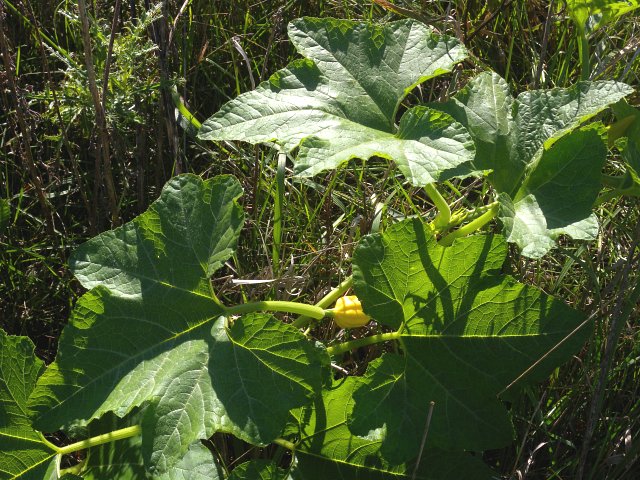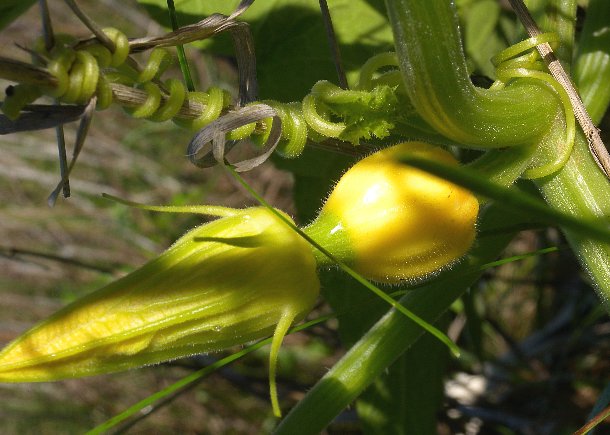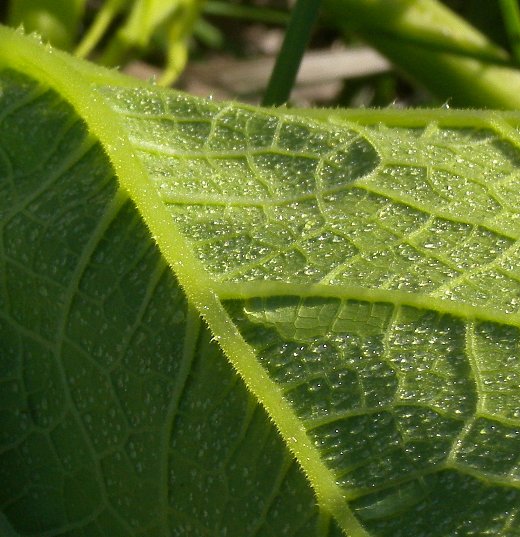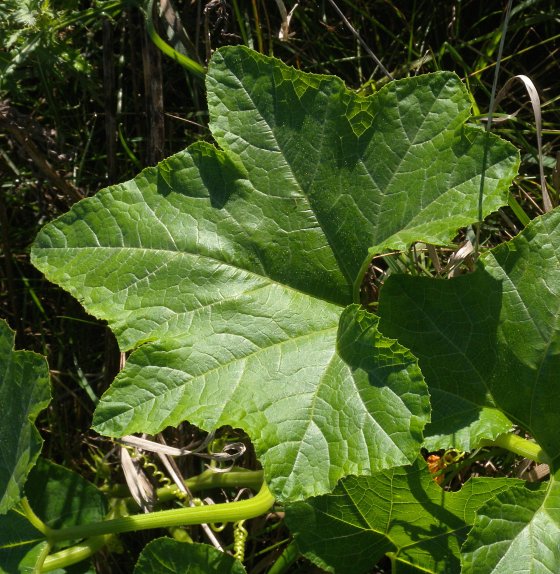Squash
Cucurbita pepo pepo
Squash family (Cucurbitaceae)
Cucurbita pepo pepo
Squash family (Cucurbitaceae)
Description:
This herbaceous vine is a summer annual about 3–9' long,
branching occasionally. This vine has a tendency to sprawl across the
ground, although it can climb adjacent vegetation and objects by means
of its tendrils. The stems are light green, short-hairy, rather
stout, and terete or bluntly angular-grooved; alternate leaves with
branched
tendrils occur at intervals along these stems. Individual leaves are
4–10" long and similarly across; they are broadly ovate-cordate or
orbicular-cordate in outline and shallowly to moderately 5-lobed. The
lobes of the leaves are broadly ovate-deltate with blunt or obtuse
tips; they are somewhat irregular in shape, while the base of each leaf
is broadly
cordate. The leaf margin is irregularly dentate and denticulate
(smaller dentate teeth); it sometimes has shallow secondary lobes. The
upper leaf surface is medium green and sparsely covered with short
stiff hairs, while the lower leaf surface is light green and
moderately covered with minute stiff hairs between the veins and longer
stiff hairs on the veins. Leaf venation is palmate for primary veins,
pinnate for secondary veins,
and reticulate tertiary veins; this is most visible
on the lower leaf surface. The petioles of the leaves are light green,
short-hairy, rather stout, and more or less terete; they are 2–6"
long and tend to curve upward from their stems. Solitary branched
tendrils occur at the base of petioles These tendrils are light green,
glabrous to sparsely covered with fine hairs, and branched toward their
tips; they
curl around adjacent vegetation or objects readily. As this monoecious
vine continues to develop during the summer, it produces both male
(staminate) and female (pistillate) flowers from the axils of the
leaves.

Both male and female flowers have a yellow to orange-yellow corolla that is 2–4" long, trumpet-shaped, and 5-lobed (less often 4-lobed or 6-lobed) when they are fully open. The lobes of the flowers are moderately deep and ovate-deltate in shape. Both male and female flowers also have hairy green calyces, each one having a short body with 5 long linear lobes; these lobes extend up to one-half of the length of the flower and they are early-deciduous. Male flowers have 3 stamens that are connate (joined together); they have fleshy white filaments with broad bases and yellow anthers that are long and narrow. Female flowers have a finely hairy inferior ovary of variable shape and color and 3 stout connate styles that each divide into a pair of oblongoid yellow to orange stigmas (6 stigmas per female flower). The blooming period occurs from mid-summer to mid-autumn, lasting about 2 months. Individual flowers open early in the morning and usually close by noon. Afterwards, the male flowers wither away, while fertile female flowers develop fruits of variable shape, color, and size. Depending on the variety or cultivar, the fruits can be white, yellow, orange, tan, green, or green- and white-striped; their shape can be cylindrical, depressed-globular, or obpyriform (reverse pear-shaped) with either straight or crooked necks. The size of mature fruits can be as small as 2–4" long and 1" across to 2' long and 2' across. The hairless rind of these fruits can be shallow to thick and either ribbed, smooth, or slightly warty. The short peduncles (basal stalks) of the fruits are rather stout, hard, and 5-angular. Each fleshy fruit contains numerous large flattened seeds. Depending on the variety or cultivar, the flesh of the fruit can be bland, sweet, or bitter in flavor. The light-colored seeds are about 1/3" (8 mm.) to 2/3" (16 mm.) long and about one-half as much across; they taper to an acute point on end and are rounded on the other end. The root system starts out as a taproot, but becomes more fibrous and divided with age. This vine reproduces by reseeding itself.

Cultivation: The preference is full sun, moist to mesic conditions, a fertile loamy soil where competition from other ground vegetation is limited. The seeds should be planted in the ground during late spring after the danger of frost has passed.
Range & Habitat: Squash occurs as a naturalized plant in widely scattered areas of Illinois, although it rarely persists longer than a year or two. The Distribution Map shows occurrences of a particular variety of this plant, Cucurbita pepo ovalifolia, which produces inedible gourds. However, most garden plants and plants that have escaped from gardens are cultivars of Cucurbita pepo pepo, which produce primarily summer squash and pumpkins. The latter are thought to be native to southern Mexico and were introduced to Illinois and other parts of the United States by Amerindians prior to the time of European settlement. Habitats for Cucurbita pepo pepo include edges of degraded marshes, riverbanks, grassy areas along roads, areas along railroads, vacant lots, fence rows, garbage dumps, and waste areas. Areas with a history of disturbance are strongly preferred.

Faunal Associations: The nectar and pollen of the flowers attract long-tongued bees, including honeybees, bumblebees, large carpenter bee (Xylocopa virginica), and long-horned bees, especially the oligoleges Peponapis pruinosa and Xenoglossa strenua (Robertson, 1929; personal observations). Striped and Spotted Cucumber beetles (Acalymma vittata, Diabrotica undecimpunctata) also visit the flowers, although they can damage this plant by gnawing on floral tissue, immature fruits, and other plant parts. Other insects that feed destructively on squash (Cucurbita pepo) are the Squash Bug (Anasa tristis), Northern Leaf Bug (Leptoglossus oppositus), Brown Stink Bug (Euschistus servus), Cotton and Potato Aphids (Aphis gossypii, Macrosiphum euphorbiae), Potato Flea Beetle (Epitrix cucumeris), Solenopsis Mealybug (Phenacoccus solenopsis), and larvae of such moths as the Squash Vine Borer (Melittia cucurbitae), Yellow Bear Moth (Spilosoma virginica), Melonworm Moth (Diaphania hyalinata), and Pickleworm Moth (Diaphania nitidalis); see Milne & Milne (1980), Froeschner (1942), Rider website (accessed 2009), Hottes & Frison (1931), Pepper (1965), Needham et al. (1928), ScaleNet website (accessed 2014), and Covell (1984/2005).

Photographic Location: A grassy area between a parking lot and a degraded marsh in Champaign County, Illinois. The photographed plant is Cucurbita pepo pepo.
Comments: There is still considerable taxonomic uncertainty regarding the classification of the many varieties and forms of the Cucurbita pepo complex. This is not surprising because there is evidence that squash (Cucurbita pepo) was cultivated in Oaxaca, southern Mexico, as long as 8,000 to 10,000 years ago (Smith, 1997). This means that squash preceded corn or beans as a cultivated edible crop by about 4,000 years. Eventually, various cultivated varieties and forms of squash then spread northward gradually from Mexico into many areas of the United States, including Illinois. The original wild ancestor of Cucurbita pepo is probably extinct. Cross-pollination of the flowers by insects, particularly bees, promotes fruit set in both wild and cultivated squash vines. Squash can be distinguished from other species in the Squash family (Cucurbitaceae) by the large size of its flowers (2–4" long), the distinctive appearance of its variable fruits, and the deeper and more pointed palmate lobes of its leaves. Other wild species in the Squash family that have never been cultivated produce inedible fruits that are dry, bitter, fibrous, small-sized, and/or very spiny.

Both male and female flowers have a yellow to orange-yellow corolla that is 2–4" long, trumpet-shaped, and 5-lobed (less often 4-lobed or 6-lobed) when they are fully open. The lobes of the flowers are moderately deep and ovate-deltate in shape. Both male and female flowers also have hairy green calyces, each one having a short body with 5 long linear lobes; these lobes extend up to one-half of the length of the flower and they are early-deciduous. Male flowers have 3 stamens that are connate (joined together); they have fleshy white filaments with broad bases and yellow anthers that are long and narrow. Female flowers have a finely hairy inferior ovary of variable shape and color and 3 stout connate styles that each divide into a pair of oblongoid yellow to orange stigmas (6 stigmas per female flower). The blooming period occurs from mid-summer to mid-autumn, lasting about 2 months. Individual flowers open early in the morning and usually close by noon. Afterwards, the male flowers wither away, while fertile female flowers develop fruits of variable shape, color, and size. Depending on the variety or cultivar, the fruits can be white, yellow, orange, tan, green, or green- and white-striped; their shape can be cylindrical, depressed-globular, or obpyriform (reverse pear-shaped) with either straight or crooked necks. The size of mature fruits can be as small as 2–4" long and 1" across to 2' long and 2' across. The hairless rind of these fruits can be shallow to thick and either ribbed, smooth, or slightly warty. The short peduncles (basal stalks) of the fruits are rather stout, hard, and 5-angular. Each fleshy fruit contains numerous large flattened seeds. Depending on the variety or cultivar, the flesh of the fruit can be bland, sweet, or bitter in flavor. The light-colored seeds are about 1/3" (8 mm.) to 2/3" (16 mm.) long and about one-half as much across; they taper to an acute point on end and are rounded on the other end. The root system starts out as a taproot, but becomes more fibrous and divided with age. This vine reproduces by reseeding itself.

Cultivation: The preference is full sun, moist to mesic conditions, a fertile loamy soil where competition from other ground vegetation is limited. The seeds should be planted in the ground during late spring after the danger of frost has passed.
Range & Habitat: Squash occurs as a naturalized plant in widely scattered areas of Illinois, although it rarely persists longer than a year or two. The Distribution Map shows occurrences of a particular variety of this plant, Cucurbita pepo ovalifolia, which produces inedible gourds. However, most garden plants and plants that have escaped from gardens are cultivars of Cucurbita pepo pepo, which produce primarily summer squash and pumpkins. The latter are thought to be native to southern Mexico and were introduced to Illinois and other parts of the United States by Amerindians prior to the time of European settlement. Habitats for Cucurbita pepo pepo include edges of degraded marshes, riverbanks, grassy areas along roads, areas along railroads, vacant lots, fence rows, garbage dumps, and waste areas. Areas with a history of disturbance are strongly preferred.

Faunal Associations: The nectar and pollen of the flowers attract long-tongued bees, including honeybees, bumblebees, large carpenter bee (Xylocopa virginica), and long-horned bees, especially the oligoleges Peponapis pruinosa and Xenoglossa strenua (Robertson, 1929; personal observations). Striped and Spotted Cucumber beetles (Acalymma vittata, Diabrotica undecimpunctata) also visit the flowers, although they can damage this plant by gnawing on floral tissue, immature fruits, and other plant parts. Other insects that feed destructively on squash (Cucurbita pepo) are the Squash Bug (Anasa tristis), Northern Leaf Bug (Leptoglossus oppositus), Brown Stink Bug (Euschistus servus), Cotton and Potato Aphids (Aphis gossypii, Macrosiphum euphorbiae), Potato Flea Beetle (Epitrix cucumeris), Solenopsis Mealybug (Phenacoccus solenopsis), and larvae of such moths as the Squash Vine Borer (Melittia cucurbitae), Yellow Bear Moth (Spilosoma virginica), Melonworm Moth (Diaphania hyalinata), and Pickleworm Moth (Diaphania nitidalis); see Milne & Milne (1980), Froeschner (1942), Rider website (accessed 2009), Hottes & Frison (1931), Pepper (1965), Needham et al. (1928), ScaleNet website (accessed 2014), and Covell (1984/2005).

Photographic Location: A grassy area between a parking lot and a degraded marsh in Champaign County, Illinois. The photographed plant is Cucurbita pepo pepo.
Comments: There is still considerable taxonomic uncertainty regarding the classification of the many varieties and forms of the Cucurbita pepo complex. This is not surprising because there is evidence that squash (Cucurbita pepo) was cultivated in Oaxaca, southern Mexico, as long as 8,000 to 10,000 years ago (Smith, 1997). This means that squash preceded corn or beans as a cultivated edible crop by about 4,000 years. Eventually, various cultivated varieties and forms of squash then spread northward gradually from Mexico into many areas of the United States, including Illinois. The original wild ancestor of Cucurbita pepo is probably extinct. Cross-pollination of the flowers by insects, particularly bees, promotes fruit set in both wild and cultivated squash vines. Squash can be distinguished from other species in the Squash family (Cucurbitaceae) by the large size of its flowers (2–4" long), the distinctive appearance of its variable fruits, and the deeper and more pointed palmate lobes of its leaves. Other wild species in the Squash family that have never been cultivated produce inedible fruits that are dry, bitter, fibrous, small-sized, and/or very spiny.